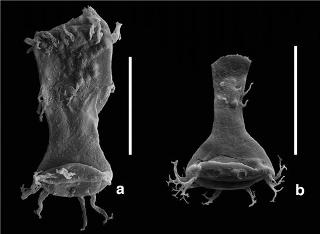Aug 26 2015
Metal poisoning caused the malformation observed in ancient organisms and may have contributed to their extinction and that of many other species.
 A malformed (’teratological’) chitinozoan specimen of the genus Ancyrochitina (a) and a morphologically normal specimen (b) of the same genus. Both of these Silurian microfossils are from the A1-61 well in Libya and are about 415 Ma old. Scale bars are 0.1 mm.
A malformed (’teratological’) chitinozoan specimen of the genus Ancyrochitina (a) and a morphologically normal specimen (b) of the same genus. Both of these Silurian microfossils are from the A1-61 well in Libya and are about 415 Ma old. Scale bars are 0.1 mm.
Several Palaeozoic mass extinction events during the Ordovician and Silurian periods (ca. 485 to 420 to million years ago) shaped the evolution of life on our planet. Although some of these short-lived, periodic events were responsible for eradication of up to 85% of marine species, the exact kill-mechanism responsible for these crises remains poorly understood.
An international team led by Thijs Vandenbroucke (researcher at the French CNRS and invited professor at UGent) and Poul Emsbo (US Geological Survey) initiated a study to investigate a little known association between ‘teratological’ or ‘malformed’ fossil plankton assemblages coincident with the initial stages of these extinction events.
Malformation and extinction
In a paper just published in Nature Communications, they present evidence that malformed fossil remains of marine plankton from the late Silurian (415 million years ago) contain highly elevated concentrations of heavy metals, such as iron, lead, and arsenic. These are well-known toxins that cause morphologic abnormalities in modern aquatic organisms; which led the authors to conclude that metal poisoning caused the malformation observed in these ancient organisms and may have contributed to their extinction and that of many other species.
Documented chemical behavior of these metals, which correlates with previously observed disturbances in oceanic carbon, oxygen and sulphur signatures, strongly suggests that these metal increases resulted from reductions of ocean oxygenation. Thus, metal toxicity, and its expressions in fossilized malformations, could provide the ‘missing link’ that relates organism extinctions to widespread ocean anoxia. As part of a series of complex systemic interactions accompanying oceanic geochemical variation, the mobilisation of metals in spreading anoxic waters may identify the early phase of the kill-mechanism that culminated in these catastrophic events. The recurring correlation between fossil malformations and Ordovician-Silurian extinction events raises the provocative prospect that toxic metal contamination may be a previously unrecognized contributing agent to many, if not all, extinction events in the ancient oceans.
Source: http://www.ugent.be/